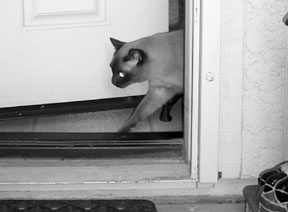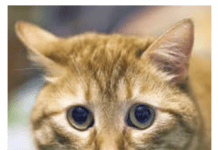Youre getting ready to leave the house. As you put on your coat, you notice your cat Sammie eyeballing you from a few feet away. You slowly open the door, hoping to step across the threshold before he runs for it. But just as you try to squeeze through the opening, Sammie darts past you in a disappearing act that would make a magician envious.


288
For many cat owners, keeping their feline companions safely indoors represents the safest care. Cats living indoors are not at risk of injuries from traffic or predators – human or animal. An indoor cat is less likely to be infected by fleas, ticks, intestinal parasites or life threatening viruses, and is less likely to get lost.
If you live with a cat that appreciates indoor living, keeping him inside is no problem. But if you live with a cat for which the great outdoors constantly beckons, preventing him from escaping the confines of your home requires consistent behavior modification.
Some cats never want to go outside, while others want to run out the door every chance they get. Most escapees are cats that have recently spent time outside, says Drew Weigner, DVM, whose practice is The Cat Doctor in Atlanta, Georgia. They can be newly adopted stray cats, outside cats made into inside cats, cats that got outside by accident, etc. It seems the call of the wild is a strong innate instinct.
Your Best Defense
If your cat is sexually intact, he or she may want to wander outside to satisfy biological urges. This is compounded if suitors are hanging around. Wanting to be outside is magnified during breeding season, usually spring and fall, says Dr. Weigner.
Spaying and neutering may help keep the feline escape artist from wanting to roam. To some degree, this does help mitigate the desire to roam, but many spayed and neutered cats still want to go outside! says Dr. Weigner.
Once a cat desires the outside world, it usually takes two things to change the behavior. One is consistency. Whatever method you choose, do it the same way, over and over again, says Dr. Weigner. Its fine to use more than one method at the same time, just as long as theyre both employed consistently. The second key to modifying your cats behavior is time and patience. It may take several months of consistent behavior modification before a cat stops trying to go outside, says Dr. Weigner.
Whatever method you use, dont involve physical punishment. Punishing a cat can destroy his trust in you and reduce his self-confidence.
Ways to Change Her Mind
Redirecting your cats attention with toys can work, as well as throwing the cat a treat as you exit, says Dr. Weigner. Keep a basket of toys or crumpled paper balls near the door to toss for your cat to chase as you leave. Youll be accomplishing two goals – giving your cat exercise and keeping him from escaping. You can also leave a trail of treats in a location away from the door for your cat to follow to distract him as you leave, or use your daily morning departure as his mealtime.
Shaking a can of pennies when the cat starts to dart, or using a squirt bottle and scat mats can all be effective deterrents if used consistently, says Dr. Weigner. A squirt bottle has the advantage of being effective when youre trying to get in the door if the door is barely opened and the cat is squirted when she puts her nose to the crack.
If possible, install a storm or screen door in addition to your regular door to give you extra protection when you come or go. Double doors are a great idea whenever feasible, says Dr. Weigner.
If your cat pushes on the window screens to let himself out, make sure the screens are securely latched, especially if you live in a high rise apartment building.
Enriching your indoor cats environment goes a long way in changing his desire to go outside. Another important aspect to changing escaping behavior is to give your cat an alternative, says Dr. Weigner. It often helps to make a window ledge so he can see outside. It also may help to put a bird feeder near the window to attract wildlife.



